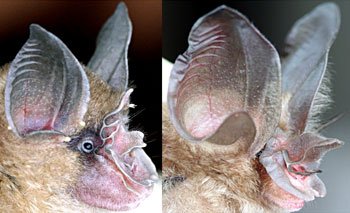
A typical horseshoe bat (left) and Bourett’s horshoe bat
By Hamish Johnston
Most biologists believe that the giraffe’s long neck evolved to allow the creature to munch on leaves not accessible to other grazing animals. But are such extreme biological features always “optimal adaptations” to specific environmental conditions? In other words, is the giraffe’s neck simply the best possible solution for reaching those tasty treetop morsels? Or did its design come about from a complicated array of evolutionary factors, some of which had nothing to do with finding dinner?
This is an important question for evolutionary biology because the study of extreme features that are true optimal adaptations could help scientists to better understand the forces that drive evolution.
Now a physicist, biologist and mechanical engineer have joined forces to show that the unusually long nose of the Bourett’s horshoe bat is the optimal size for focusing a beam of ultrasound — which the bat uses to navigate.
Native to the rain forests of south east Asia, the bat has a nose that’s about 9 mm long — which is about twice the length of a typical horseshoe bat.
The team used a computer model to calculate the acoustic properties of the “noseleaf” — a structure that protrudes from the bat’s nose and is made of made of folded skin called “sella”
You can read their paper in Physical Review Letters.
They looked at a number of different nose lengths and “By predicting the width of the ultrasonic beam for each of these nose lengths with a computational method, we found that the natural nose length has a special value”, explained team-leader Rolf Mueller of Virginia Tech. in the US.
“All shortened noses provided less focus of the ultrasonic beam, whereas artificially elongated noses provided only negligible additional benefits. Hence, this unusual case of a biological shape can be predicted accurately from its physical function alone.”
So that’s how Bourett’s horshoe bat got its big nose.



